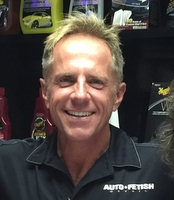Auto Engine Detailing
Don't panic, it's easier than you think!
Auto engine detailing is an area of car detailing and car care that is filled with much more bad information than good!
Anyone looking under the hood of their car will become instantly fearful with the thought of water coming in contact with the car engine and its many moving parts, electrical connectors, and fuses.
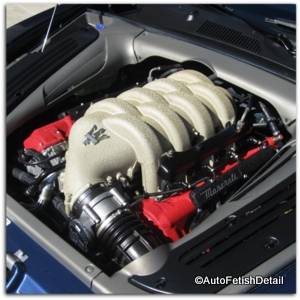
The combination of bad information from misinformed people, along with a natural level of concern leaves no doubt as to why so many people are unwilling, or very fearful of trying to clean a car engine. The reality is that while a little common sense should be applied to every area of life, the good news is that learning how to detail a car engine is much easier than most could ever imagine!
A Clean Engine is a Happy Engine
It is unlikely I would have to explain why you would want to clean your engine; otherwise you would not be here. But there are other reasons a person may find themselves "needing" to detail or clean their engine aside from just "wanting" a clean engine.
One day you may find your mechanic insisting you get your engine cleaned or degreased so he can figure out where a leak is coming from, or for a variety of other repairs.
Let me tell you all the many reasons I recommend cleaning and detailing your car engine:
- I love the look of a perfectly clean and detailed engine.
- Unless you are a plant or worm; dirt is an enemy to everything! Including your car engine and the endless components of your engine.
- When your engine is clean, it presents the ability to see the beginning of a problem sooner, rather than later. (oil leaks, water leaks, worn belts, etc.)
- I believe that when you take your car in for service; any mechanic will not only prefer to work on a clean engine, but will actually treat your car better. A clean engine will provide for a happier mechanic (we want a happier mechanic) and will strongly suggest to your mechanic that you are a more discerning and particular customer. There will be a greater expectation put upon him to perform to a higher standard on your car than the typical dirty-ass car engine)
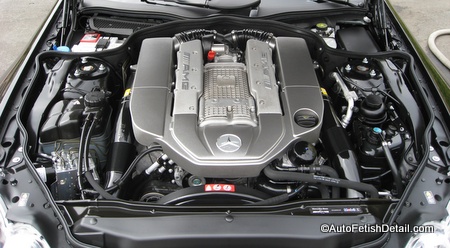
"I have heard that you should never get your engine wet, or that there are certain parts of your engine that have to be covered if you are going to clean the engine of your car."
Yes, a hundred years ago that statement would have been much more relevant and true. But today's engines are not the engines of yesterday.
If you lift the hood to where your engine is hiding out and examine the way it is built, you will begin to see how most modern day engines have much in the way of covers and shrouding.
You should also examine all the
electrical connectors and observe how protected they are. Not only are
all the electrical connectors built with heavier duty connectors, but
are typically assembled using a grease like substance that protects the
actual contact points from moisture and water.(this cannot be seen unless you disconnect the connectors)
This is all good news!
Auto Engine Detailing:
Is it really safe?
The simple answer is YES!
By this point you are likely beginning to come to a new understanding of modern day engines and your ability to actually clean and detail a car engine...
specifically, YOUR car engine!!
"But Darren, what about the fuse box or alternator; surely these cannot become wet?"
Yes and no.
Allow me to explain.....
- A big majority of cars have the fuses located inside your car.
- If the fuse box is located in the engine bay, it is fully housed in a fuse box that is built to be very secure and protected from dirt, moisture, and water. (unless it is severely damaged, you would have to try very hard to get water into this box)
- Cars today have fuel-injection systems which are completely contained systems that are air and water tight. (there are very few exceptions to this rule. On a few of the Ford truck engines, the seals around the fuel injectors have the ability to leak water through. This is the only exception I have come across in the 30 years I have been auto engine detailing. If you are still concerned, you can ask your mechanic.)
- With the steps I recommend below, I show you how to go about auto engine detailing in the safest of ways.
Clean Engine or Dirty Engine:
Which one would you rather have
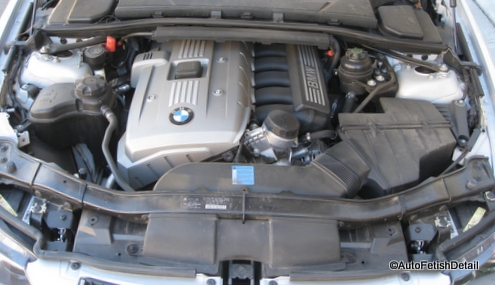 BMW engine before engine detailing
BMW engine before engine detailing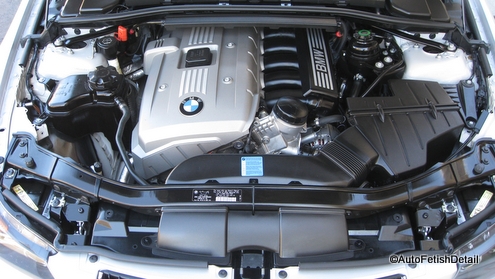 BMW engine after engine detailing
BMW engine after engine detailing
Auto Engine Detailing:
The actual steps to a clean engine
- To be performed on cool to warm engine. Cleaning and detailing a very hot car engine is not advisable. If you cannot rest your hand on the top of the engine (the intake manifold specifically) for approximately 30 seconds, I would consider this a hot engine.
- Spray entire engine with degreaser.
- Use any brushes necessary to break-up areas of excessive dirt/grease/oil build-up.
- Hose off using tap water from your garden hose with either a water nozzle attached for directional pressure, or an electric pressure washer.
- Use leaf blower (or compressed air if you have access to an air compressor) to blow engine so no standing water exists within engine bay. Paying special attention to what you might consider sensitive areas.
- Wipe down any standing water present on car paint, glass, etc. to prevent water-spotting. (You may want to do this prior to blowing the engine off with the leaf blower)
- Start engine and allow engine to heat up to normal operating temperature. (approximately 10 minutes) to allow any moving parts or belts to dry completely. (occasionally you will hear a squeal from the fan belts upon initial start-up. As a rule this will stop within the first few seconds. If it continues for the duration of the first two minutes, you might need to use some belt lubricant that can be purchased from your local auto parts store. This has happened one time in my 30 year career.)
- Apply some form of dressing to engine if you want a truly detailed and shiny engine. (this is not a requirement, but simply for visual enhancement of your car engine.)
- Stand back in amazement at your amazing results.
Engine Degreasers that Work!
And work safely
A quality engine degreaser like the ones below will produce amazing results. Both products are concentrates and can be custom diluted based on your needs.
Simple Green Extreme Aircraft and Precision Cleaner, 1 Gallon Bottle 13406
- Unique formulation custom made for the high demands of the aerospace industry
- Concentrate allows you to custom blend based on your needs
- Mix according to label instructions
- Also an excellent cleaner/degreaser for countless jobs on your car or around the house
- Not a dedicated degreaser packaged for the auto detailing world, but one of my favorites
Adam's ECO All Purpose Cleaner Gallon - Industrial Strength, Concentrated Formula Can be Diluted Down - Tough on Dirt but Easy on Your Car, You, and The Environment
- Another excellent product that comes in a concentrate that makes for economical sense
- Effective at cleaning your car engine as well as countless other car cleaning jobs
- Very popular product for the world of detailing and car enthusiasts
Tools for Professional Results
Smith 190285 1-Gallon Bleach and Chemical Sprayer for Lawns and Gardens or Cleaning Decks, Siding, and Concrete
- Saves your grip from exhaustion over using a traditional pump sprayer.
- Can be filled with any of your chemicals where much spraying is needed.
- Simply fill the container with your degreaser, add appropriate amount of water to create your desired dilution ratio, pump to compress air, and simply point and shoot.
- A much quicker and easier way to completely cover your engine with degreaser.
Darren's Tip: If you have ever had to spray large amounts of liquids from a traditional sprayer, you will love this pump sprayer! Just add your favorite degreaser or cleaner to this sprayer, pump to pressurize, and you can cover your entire engine with degreaser in under a minute rather than a few minutes of traditional pump sprayer and a rather tired hand when done.
Auto Engine Detailing:
Detail Brushes
Use the brushes below to take your auto engine detailing to a higher level of results and professionalism.
I am offering two choices based on you and your needs. Either choice promise to deliver professional results.
- If you keep up on your auto engine detailing and overall cleaning, you may never need the additional help these brushes can offer.
- For the rest of us; you will likely need to agitate the heavily soiled areas with one of these brushes once you have saturated your engine with your choice in an engine degreaser from above.
- This is the exact brush kit I use professionally for engine detailing, wheel cleaning, wheel wells, undercarriage, or the underside of your hood.
- Durable nylon bristles that are also feather at the tips for an extra level of effectiveness and safety.
- An excellent brush capable of many uses. (auto engine detailing is only one of many uses)
- Feather tips for effectiveness and safety.
- A number one seller based on reviews.
- Softer brushes than the green ones above. (this can be both the good news and the bad news based on the amount of dirt and grease build-up you are dealing with when auto engine detailing.
Auto Engine Detailing:
Engine Dressing
Dressing your engine as part of the auto engine detailing is a requirement for me and my world. You may come to a different conclusion based on your preference.
Darren's Note: Many people get "wiggy" about applying a dressing to their car engine. I have always been a huge fan; but it's not for everyone. Many people will also become wiggy once they read some of the labels of traditional dressings due to the flammable warning labels; especially the aerosol dressings. Just read the descriptions below and decide which one you are most comfortable with.
- Really makes your engine "POP" after you have done the initial cleaning.
- Doesn't necessarily "attract" dirt/dust, but will allow dirt/dust to stick to your engine better.
- Rather than only look at this as a problem, you might also consider a dressing as a sacrificial layer. A superficial layer that now prevents dirt from actually touching your engine and components, but can easily be cleaned off each time, It is a matter of perspective and experience.
- I know many off-roaders that accept that dirt will "stick" to a freshly dressed engine, but understand that it is easily cleaned away with the accumulated dirt when they perform the auto engine detailing each time.
- You apply dressing after you have blown the engine off to remove excess water before starting engine. I use an electric leaf blower as can be seen in the videos below.
CSI Nu Tyre Lotion Quart 62-208-Q
- One of my "go-to" engine dressings
- The actual dressing I use for any of my car dressing needs for both interior and exterior use: Tires, engines, car leather, black plastic trim, etc., etc.
- True waterborne technology (dries to the touch)
- No-sling formulation for tires
- My favorite "all-purpose" dressing that has so many uses
CarPro PERL Coat Plastic & Rubber Protectant 500 ml
- One of the few dressings that are actually labeled for use on engine's.
- If you choose this one, I recommend diluting it down with tap water 1;1. (this means half dressing, and half water)
- A thinner consistency works better on car engines than the thicker consistency.
Stoner Car Care More Shine Tire Dressing - 18 oz, 91084
- Aerosol dressings are a very easy way to apply a dressing to your car engine and can access all the intricate parts of your car engine
- Not as economical as using one of the dressings above, but very easy to use
- Any aerosol will be flammable due to the propellant.
- I never use on a running or hot engine. Cool to warm engine's only.
- The actual dressing is not flammable so once you have sprayed the engine, you will not have to worry.
- I have used aerosol dressings ever since I first started detailing engines well over twenty years ago and have never had a single problem.
- There are many aerosol dressings you can choose from and I demonstrate many different types within the many auto engine detailing videos I have done. They all perform similarly enough where you don't need to overthink it.
- If you live in an area where you depend on air freight for shipment, you will not be able to order the aerosol
- Simply spray entire engine with a light application once you have finished blowing engine off, allowed engine to run until it reaches normal operating temperatures, and allowed to cool back down. I promise; you will be amazed!
Auto Engine Detailing Summary
If you have made it this far down this page, you deserve a badge of honor! Most people simply do not have the interest in learning the nuances of any given subject of detailing or auto engine detailing to actually become a truly informed car owner.
Therefore I congratulate you!
I hope I have helped you so you can better results in your world.
Sincerely,
Darren Priest
|
|








